INDIA: SOMETHING ALWAYS HAPPENS
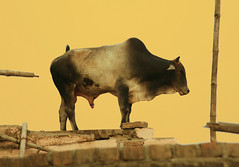
Heaven, Heaven is a place
A place where nothing,
Nothing ever happens
David Byrne
Events never stand still for long in this part of the world. Entering India from anywhere, even if it’s just walking over the border from Sonauli, Nepal, like we have done, is like getting caught up in a maelstrom. And that’s when nothing particularly special is happening. Last week, as we were on an overnight train from Varanasi to Delhi, a group of terrorists stormed our old stomping ground in Colaba, Bombay, and went on a killing spree around the 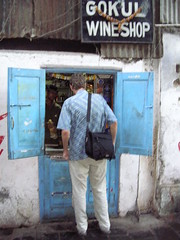 neighbourhood we are so fond of (including the Gokul, where we bought beer, and where a bomb was found). Like much of the country, we watched events unfold with a horrified fascination, flipping from channel to channel as reporters tried to coax meaningful tidbits of information from a story that was exploding around them like a mushroom cloud. We were staying in the Tibetan Colony in Delhi, which in these circumstances is about the best place to be, since our little burgundy-robed community is hardly a prime target for someone who has a grudge against the “Crusader/ Zionist/Hindu” axis. Nevertheless, we went about our business as usual, riding the metro to Pahar Ganj to change money, and going to see our scarf suppliers, Parmindar and Amrita, at their place in Patel Nagar.
neighbourhood we are so fond of (including the Gokul, where we bought beer, and where a bomb was found). Like much of the country, we watched events unfold with a horrified fascination, flipping from channel to channel as reporters tried to coax meaningful tidbits of information from a story that was exploding around them like a mushroom cloud. We were staying in the Tibetan Colony in Delhi, which in these circumstances is about the best place to be, since our little burgundy-robed community is hardly a prime target for someone who has a grudge against the “Crusader/ Zionist/Hindu” axis. Nevertheless, we went about our business as usual, riding the metro to Pahar Ganj to change money, and going to see our scarf suppliers, Parmindar and Amrita, at their place in Patel Nagar.
Pahar Ganj, the noisy bustling market opposite the New 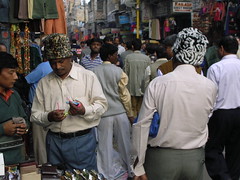 Delhi train station, had been the victim of a bomb blast last year. The security response was to put in a walk-through metal detector, the kind that is used in airports. It is still there, and it is still as futile a device for protecting the market as a mop and a pail is for stopping a tsunami. Cycle rickshaws, scooters and even cars just zip past it, and pedestrians ignore it all together. Sometimes we walk through it because it’s the only space available in the crush of the street, and the poor thing bleeps dutifully into the cacophony, and no one gives a second glance. As we were about to leave through the forlorn security gate a reporter from the Times of India and her photographer approached us, and asked a few questions about our reaction to the situation. Were we afraid? Would we change our plans because of the events? They were talking to an Italian tour group who were catching the next flight home
Well, that’s just not our style. We weren’t planning to go to Bombay on this trip, but if we were, we wouldn’t change our plans. Fear-based reactions to an event make things much worse than the event itself. We coddle this idea of security which is an illusion, that we can somehow control the big boot of fate that is stomping all around us. Like the French tourist who left Bombay because of the attacks, came to Jaipur (where we are now), and died falling off the palace wall. Maybe we were a bit too vociferous for the reporter. Instead of the front page spread we anticipated, we didn’t even make the entertainment section in the paper the next day.
Delhi train station, had been the victim of a bomb blast last year. The security response was to put in a walk-through metal detector, the kind that is used in airports. It is still there, and it is still as futile a device for protecting the market as a mop and a pail is for stopping a tsunami. Cycle rickshaws, scooters and even cars just zip past it, and pedestrians ignore it all together. Sometimes we walk through it because it’s the only space available in the crush of the street, and the poor thing bleeps dutifully into the cacophony, and no one gives a second glance. As we were about to leave through the forlorn security gate a reporter from the Times of India and her photographer approached us, and asked a few questions about our reaction to the situation. Were we afraid? Would we change our plans because of the events? They were talking to an Italian tour group who were catching the next flight home
Well, that’s just not our style. We weren’t planning to go to Bombay on this trip, but if we were, we wouldn’t change our plans. Fear-based reactions to an event make things much worse than the event itself. We coddle this idea of security which is an illusion, that we can somehow control the big boot of fate that is stomping all around us. Like the French tourist who left Bombay because of the attacks, came to Jaipur (where we are now), and died falling off the palace wall. Maybe we were a bit too vociferous for the reporter. Instead of the front page spread we anticipated, we didn’t even make the entertainment section in the paper the next day.
Understandable, in retrospect. Last Saturday was also the state election in Delhi, so there was a lot to write about. For the last 8 years the Congress Party has held power in the Capital District. This in itself is almost enough to doom them, since Indians are notorious for their “anti-incumbency” pattern, voting for a different set of scoundrels every time as if it will change anything. In this case, however, our little 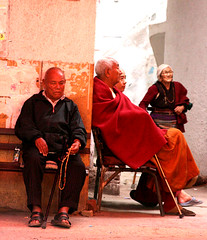 burgundy-robed community was watching closely. The Tibetan Colony, as it is known, was established as an illegal squat on unwanted land in 1959. It has grown into a small but prosperous and well-organized community, even though only a few of the residents has citizenship, and all the properties that are bought and sold and rented don’t officially exist. Delhi is to host the 2010 Commonwealth games, and this site was to have been torn down for one of the venues. Last year when we were here everyone was quite pessimistic. But since then the pending case has been settled, and the Chief Minister, Sheila Dikshit, assured the Tibetans they could stay. The new fear is that if the BJP win, who are unabashedly pro-Hindu, the colony’s fate may once more be up in the air. But enough of serious subjects with grave consequences.
burgundy-robed community was watching closely. The Tibetan Colony, as it is known, was established as an illegal squat on unwanted land in 1959. It has grown into a small but prosperous and well-organized community, even though only a few of the residents has citizenship, and all the properties that are bought and sold and rented don’t officially exist. Delhi is to host the 2010 Commonwealth games, and this site was to have been torn down for one of the venues. Last year when we were here everyone was quite pessimistic. But since then the pending case has been settled, and the Chief Minister, Sheila Dikshit, assured the Tibetans they could stay. The new fear is that if the BJP win, who are unabashedly pro-Hindu, the colony’s fate may once more be up in the air. But enough of serious subjects with grave consequences.
“So, how’s the shopping going?” you ask. Well… It’s been a frenzied circus of out-of-control extravagance. Bucking the trend of belt-tightening and penny-pinching in the face of looming global financial catastrophe, we have hit India like a monsoon of dollar bills. It’s part of the Kebe and Fast plan for economic recovery – similar to Stephen Harper’s: we take a healthy surplus from last year and run it into a free-spending orgy of a deficit. The good news – for all our loyal shoppers out there – is that we are getting great stuff, and lots of it. The Nepal shipment has already arrived in Vancouver, and with the generous help of Robert and Nicole* and Marianne and David, has been safely cleared and stored. *(A footnote: We are unbelievably pissed off that R and N’s trip to Asia, where at some point we were to meet up, has been the victim of the PAD blockade of Bangkok’s airport. These were the same demonstrators we met two blogs ago; how could they do that to us?)
Our first Indian stop was Varanasi. For the first time in all of 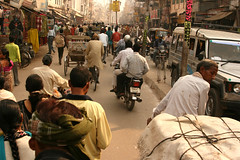 our visits here, we decided to stay outside of the noisy carnival of the old city. What we didn’t take into account was the advent of Wedding Season. As with everything here, an Indian wedding is not a subdued, timid intimate affair. Usually the number of guests is in the hundreds or thousands, and the venue is an expensive hotel, a “marriage hall” or a “farm” outside the city center. Which is exactly where our hotel happened to be. Our first night we had weddings in stereo, coming from the hotel courtyard where the tents, the buffet and the band were set up, and from a location behind our room. When we went to see our merchant Ajit the next day, he was in worse shape than us. The height of Wedding Season is six weeks in Dec. and Jan. when the astrological configurations are favourable, and during that time, he said, he was invited to a different wedding every day. Most he turned down, but for some the connection was too close/too influential to be avoided. The later was the case with the politician’s family the night before, which he was still sleeping off. A few days later it was a case of the former: a family friend who pedaled around the old city selling milk from jugs on the back of his bicycle. He was by no means well-to-do, but had invited 1500 people to his daughter’s wedding. Much of the cost for these extravagances is defrayed by the guests, who leave an envelope with a donation, but this man had cut the catering corners so fine that it appeared the event would run out of food – which would be a major loss of face. Ajit and some others had to leave on a mission to replenish the supplies and save the situation. It’s one of those near-disasters every wedding seems to have, and reminds me of last summer when we were set up in the middle of our sale on Denman Is., where our display tables had apparently been double-booked for a wedding, and only some frantic running around averted a disaster.
our visits here, we decided to stay outside of the noisy carnival of the old city. What we didn’t take into account was the advent of Wedding Season. As with everything here, an Indian wedding is not a subdued, timid intimate affair. Usually the number of guests is in the hundreds or thousands, and the venue is an expensive hotel, a “marriage hall” or a “farm” outside the city center. Which is exactly where our hotel happened to be. Our first night we had weddings in stereo, coming from the hotel courtyard where the tents, the buffet and the band were set up, and from a location behind our room. When we went to see our merchant Ajit the next day, he was in worse shape than us. The height of Wedding Season is six weeks in Dec. and Jan. when the astrological configurations are favourable, and during that time, he said, he was invited to a different wedding every day. Most he turned down, but for some the connection was too close/too influential to be avoided. The later was the case with the politician’s family the night before, which he was still sleeping off. A few days later it was a case of the former: a family friend who pedaled around the old city selling milk from jugs on the back of his bicycle. He was by no means well-to-do, but had invited 1500 people to his daughter’s wedding. Much of the cost for these extravagances is defrayed by the guests, who leave an envelope with a donation, but this man had cut the catering corners so fine that it appeared the event would run out of food – which would be a major loss of face. Ajit and some others had to leave on a mission to replenish the supplies and save the situation. It’s one of those near-disasters every wedding seems to have, and reminds me of last summer when we were set up in the middle of our sale on Denman Is., where our display tables had apparently been double-booked for a wedding, and only some frantic running around averted a disaster.
With Ajit we stocked up on a number of our staples, including  a duvet set we designed to be even more robust than last year, and some of the specialties of the area like the zardozi work.
a duvet set we designed to be even more robust than last year, and some of the specialties of the area like the zardozi work.
We changed hotels after our first night, and I have to admit it was nice to be away from the hype and intensity of the old city. For one thing we didn’t have the barrage of touts targeting us everywhere, from the sleazy whispers of “hash” in the alleys to the smarmy solicitations of “see my silk factory” to the interminable “Hello, boat?” along the ghats. 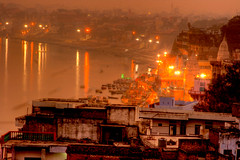 It is a fact of life you get used to and can generally brush off quite easily, but once in a while you come across one that just floors you. At the train station in Kandy, Sri Lanka, for instance, a vendor of stuffed toys yelled out at us “Hello Small Chicken!”, and now, walking down the crowded Gowdalia market Katheryn was approached with the line “Hello Madam. Undergarments looking?”
It is a fact of life you get used to and can generally brush off quite easily, but once in a while you come across one that just floors you. At the train station in Kandy, Sri Lanka, for instance, a vendor of stuffed toys yelled out at us “Hello Small Chicken!”, and now, walking down the crowded Gowdalia market Katheryn was approached with the line “Hello Madam. Undergarments looking?”
Now I am sitting in the very pleasant garden of our hotel in Jaipur. As of this year Jaipur has become the major source for our goods, since a number of other suppliers have consistently disappointed us with the quality of their work. We made a small order with Kishor last year and were very pleased by it, so this year we have gone a little crazy. Jaipur is the clearing house for much of the textiles and jewelry that comes out of Rajastan, Gujurat, and Pakistan, and we have stocked up on the wall hangings made with salvaged pieces of old clothing that are so endlessly fascinating. Kishor and his family come from Sind province in Pakistan, and were Hindu hold-outs there for 25 years after partition. His father is an authority on traditional tribal embroidery, and has pieces in his collection which are fantastic, but far out of our price 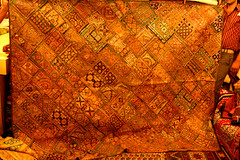 range. What we did get is far more Zari, the metallic-thread embroidery which comes from Baluchistan, on the Afghan border. It is such impressive work it should be in the “for collectors only” category, but even though the good stuff is over 20 years old, it is still relatively plentiful, and therefore affordable. Jaipur is also the center of the block-print universe, and it seems perverse we didn’t pick up more of it earlier. Perhaps we were just reacting to the glut of faux-peasant skirts and warriors-on-camels bedspreads that have for so long been the standard of the back-packer
range. What we did get is far more Zari, the metallic-thread embroidery which comes from Baluchistan, on the Afghan border. It is such impressive work it should be in the “for collectors only” category, but even though the good stuff is over 20 years old, it is still relatively plentiful, and therefore affordable. Jaipur is also the center of the block-print universe, and it seems perverse we didn’t pick up more of it earlier. Perhaps we were just reacting to the glut of faux-peasant skirts and warriors-on-camels bedspreads that have for so long been the standard of the back-packer 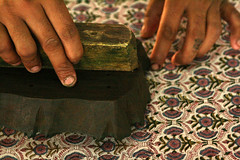 entrepreneur. What Kishor has done is dip into the vocabulary of 17th C Moghul architecture, particularly the inlaid marble work, and made blocks from these motifs. We visited the studio where the work is done, south of the city,
entrepreneur. What Kishor has done is dip into the vocabulary of 17th C Moghul architecture, particularly the inlaid marble work, and made blocks from these motifs. We visited the studio where the work is done, south of the city,  and while it would be romantic to say it was a village of mud huts in the desert, the reality is that the village has come to the city. The workshops are bright and spacious, and the block makers and printers are Muslim men.
and while it would be romantic to say it was a village of mud huts in the desert, the reality is that the village has come to the city. The workshops are bright and spacious, and the block makers and printers are Muslim men.
With Kishor’s help we have designed some new product lines for 2009. Probably the one we are most excited about Kishor calls “Moghul” work. We have selected seven patterns of this to be made into king and queen duvet sets with shams, on the best Indian cotton that he has, as well as table cloths and napkins with the same designs. One of the things about block-print, to the untrained eye, is that it can look like machine print. This is like comparing a poster to a painting. The “Blue Cornflower” pattern, for instance, 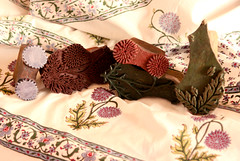 requires the use of five different blocks, applied by hand, for every flower on the sheet.
requires the use of five different blocks, applied by hand, for every flower on the sheet.
This is our last day in Jaipur, and tomorrow another adventure begins. We are heading into the deep south of Gujurat, into a little-visited area called the Kathiawar peninsula. Stay tuned for more.
Your foreign devil correspondent.
